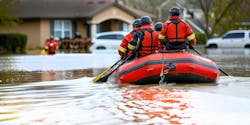As rescuers, we routinely work in close proximity to pressurized "fluids" - hydraulic oil in power rescue tool systems and hydraulic jacks, compressed air in our rescue airbags, air chisels or air impact wrenches. At a crash scene, patients as well as responders from other agencies also come close to these pressurized sources. When everything goes right, these pressurized fluids stay within their systems and everything works as planned. This University of Extrication column is presented to reinforce how pressurized fluid leaks as small as a pinhole can be extremely dangerous.
Photo by Ron Moore Probably the most common injury associated with hydraulic systems is the result of small, almost invisible pinhole leaks in hydraulic hoses or couplings. A high-pressure injection can cause severe burns, lacerations and amputations, eye injury and blindness.
The most common fluid rescuers work with on a daily basis is hydraulic fluid. Three kinds of hazards exist when a pressurized hydraulic system leaks under pressure: burns from the hot, high pressure spray of fluid; bruises, cuts or abrasions when struck by ruptured hydraulic lines, and high-pressure hydraulic injection of fluid into and under the skin. A high-pressure injection can cause severe burns, lacerations and amputations, eye injury and blindness.
Pinhole Leak Injuries
Probably the most common injury associated with hydraulic systems is the result of small, almost invisible pinhole leaks in hydraulic hoses or couplings. These leaks are difficult to locate. A rescuer may notice a damp, oily, dirty place along a hydraulic hose or at a coupling. Because the high pressure causes the fluid to spray out so fast, the rescuer tends to run their hand or finger along the hose to find the leak. When the pinhole is reached, the fluid easily can be injected into the skin as if from an invisible hypodermic syringe. The pressure of the spraying fluid is powerful enough to tear right through a glove and still inject into the rescuer's hand.
Caught up in the adrenalin rush of the extrication, the slight stinging sensation may be overlooked. Medical authorities report, however, that several hours later the wound will begin to throb and severe pain will begin. By the time a doctor is seen, it is often too late, and the individual stands to lose a finger or entire arm. Time between the injury and the removal of the injected material is absolutely critical. Studies indicate that results are progressively worse with greater delays in seeking treatment.
Injection injuries must be considered true medical emergencies. They have been recognized as devastating and have a reputation as being associated with infection, disability and a high rate of amputation. The non-dominant hand (the left hand more often than the right) is injured more than twice as frequently as the dominant hand. The most common specific sites are the end of the left middle and index fingers.
Photo by Ron Moore A test conducted by Farmedic demonstrates the devastation possible from a high-pressure fluid injection injury. A thawed hot dog, which simulates a rescuer’s finger, is exposed to a spray of hydraulic oil. Using a manual pump, a pressure of 3,000 psi is created and then suddenly released through the pinhole orifice. The fluid instantly tears into the “flesh” of the hot dog.
Specialists in emergency departments and even surgeons at times have missed the diagnosis of high-pressure injection injury. This has resulted in cases of gangrene requiring amputation of the affected site. Therefore, it is very important for emergency responders to have a heightened awareness of the seriousness of this injury.
The Farmedic Demo
A New York State-based agricultural rescue training organization, Farmedic, graphically demonstrates the devastation possible from a high-pressure fluid injection injury with a simple simulator.
A thawed hot dog, which simulates a rescuer's finger, is exposed to a spray of hydraulic oil. Using a manual pump, a pressure of 3,000 psi is created and then suddenly released through the pinhole orifice. The fluid instantly tears into the "flesh" of the hot dog.
Even when the hot dog is placed inside the finger of a typical rescuer glove, the fluid penetrates enough to do damage.
Prevention Protocols
When working with hydraulic systems, never feel for leaks on high-pressure lines. To reduce the chances of this type of injury, run a piece of paper or cardboard along the hose rather than your hand or fingers to detect if there is a leak or not. In addition, never disconnect any hydraulic line or system that has not been de-energized.
All hydraulic systems must be on a preventive maintenance schedule that includes inspection of lines and regularly scheduled replacement according to manufacturers' recommendations. The maintenance schedule must consider the type of working environment - for harsh environments, more frequent inspections may be required.
Photo by Ron Moore To avoid injury when working with hydraulic systems, never feel for leaks on high-pressure lines with your hand or fingers and never disconnect any hydraulic line or system that has not been de-energized.
TASK: Given a vehicle rescue scenario, explain your department's protocols for handling a high-pressure injection injury.
Online sources for follow-up information about high-pressure injection injuries:
www.farmedic.com/Hydraulic%20injection.htm
www.postgradmed.com/issues/2000/07_00/mizani.htm
www.safteng.net/Accident%20Photos/safety_topic_high_pressure_injec.htm
www.cdc.gov/nasd/docs/d000801-d000900/d000891/d000891.html
Ron Moore, a Firehouse® contributing editor, is a battalion chief and the training officer for the McKinney, TX, Fire Department. He also authors a monthly online article in the Firehouse.com "MembersZone" and serves as the Forum Moderator for the extrication section of the Firehouse.com website. Moore can be contacted directly at [email protected].









